2020 MERCEDES-BENZ GLA tire pressure
[x] Cancel search: tire pressurePage 313 of 346
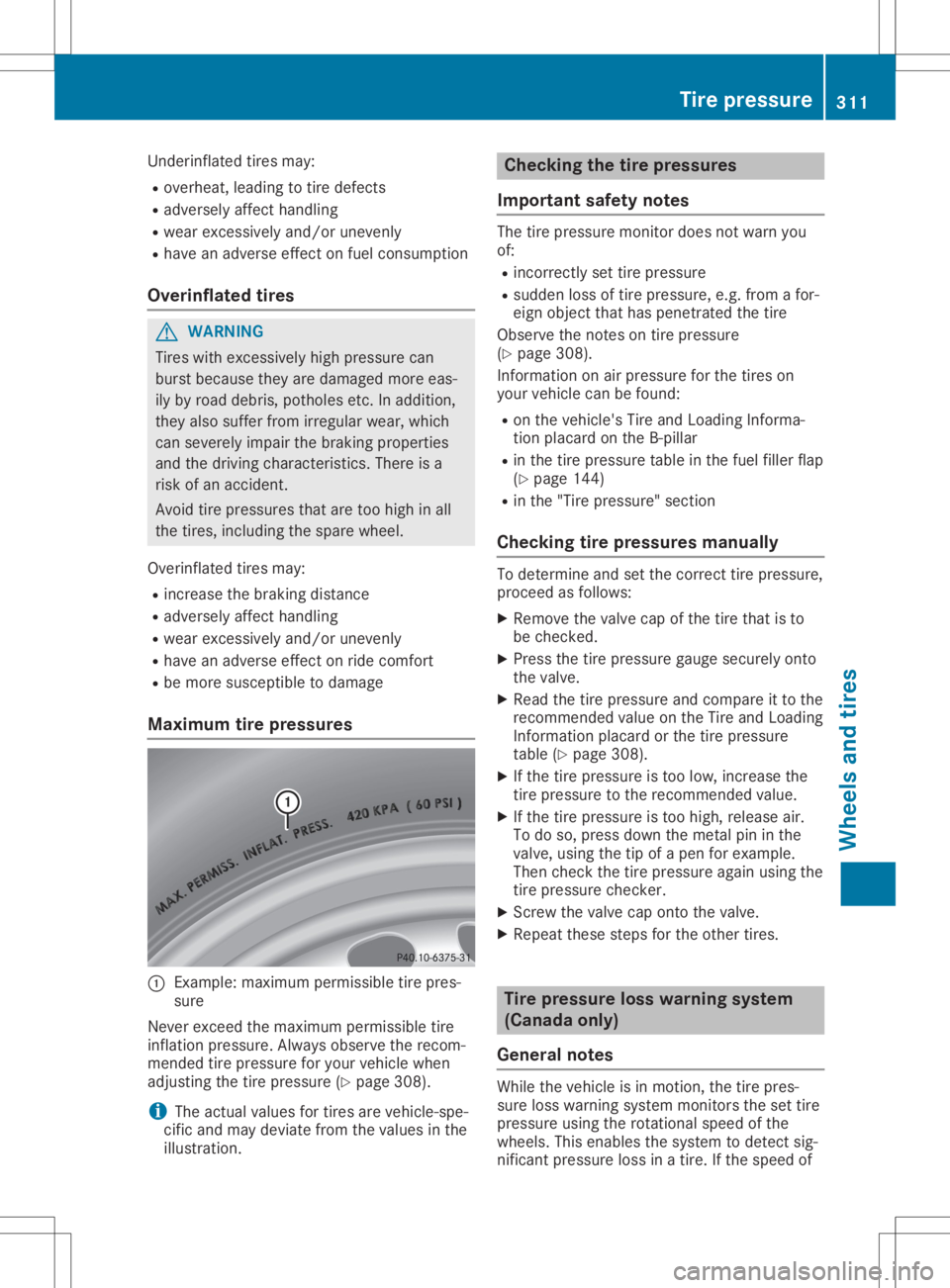
Underinflated
tiresmay:
R overheat, leadingtotire defects
R adversely affecthandling
R wear excessively and/orunevenly
R have anadverse effectonfuel consumption
Overinflated tires G
WARNING
Tires withexcessively highpressure can
burst because theyaredamage dmore eas-
ily by road debris, potholes etc.Inaddition,
they alsosuffer fromirregula rwear, which
can severely impairthebraking properties
and thedriving characteristics. Thereisa
risk ofan accident.
Avoid tirepressures thataretoo high inall
the tires, including thespare wheel.
Overinflated tiresmay:
R increase thebraking distance
R adversely affecthandling
R wear excessively and/orunevenly
R have anadverse effectonride comfort
R be more susceptible todamage
Maximum tirepressures 0043
Example: maximum permissibletire pres-
sure
Never exceed themaximum permissibletire
inflation pressure. Alwaysobserve therecom-
mended tirepressure foryour vehicle when
adjusting thetire pressure (Ypage 308).
i The
actual valuesfor tires arevehicle-spe-
cific andmay deviate fromthevalue sin the
illu stration. Checki
ngthe tire pressures
Importa ntsafety notes The
tirepressure monitordoesnotwarn you
of:
R incorrect lyset tire pressure
R sudden lossoftire pressure, e.g.from afor-
eign object thathaspenetrated thetire
Observe thenotes ontire pressure
(Y page 308).
Information onair pressure forthe tires on
your vehicle canbefound:
R on the vehicle's TireandLoading Informa-
tion placard onthe B-pillar
R in the tire pressure tableinthe fuel filler flap
(Y page 144)
R in the "Tire pressure" section
Checki ngtire pressures manually To
determine andsetthe correct tirepressure,
proceed asfollows:
X Remove thevalve capofthe tire that isto
be checked.
X Press thetire pressure gaugesecurely onto
the valve.
X Read thetire pressure andcompare itto the
recommended valueonthe Tire andLoading
Information placardorthe tire pressure
table (Ypage 308).
X Ifthe tire pressure istoo low, increase the
tire pressure tothe recommended value.
X Ifthe tire pressure istoo high, release air.
To do so, press downthemetal pininthe
valve, usingthetipofapen forexample.
Then check thetire pressure againusing the
tire pressure checker.
X Screw thevalve caponto thevalve.
X Repea tthese stepsforthe other tires. Tire
pressure losswarning system
(Canada only)
General notes While
thevehicle isin motion, thetire pres-
sure losswarning systemmonitors thesettire
pressure usingtherotational speedofthe
wheels. Thisenables thesystem todetect sig-
nificant pressure lossinatire. Ifthe speed of Tire
pressure
311Wheelsandtires Z
Page 314 of 346
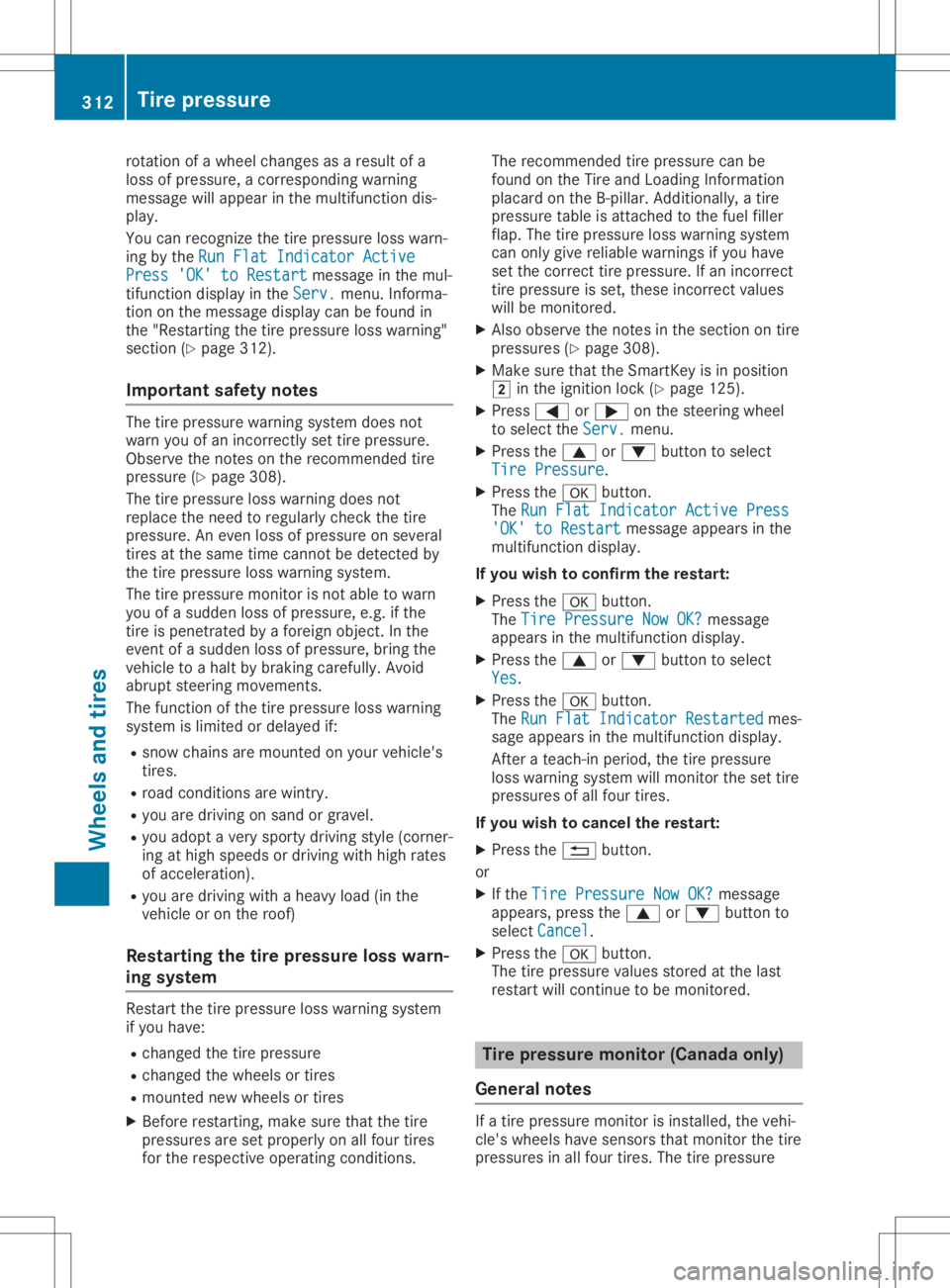
rotation
ofawhee lchanges asaresul tof a
loss ofpressu re,acorrespo ndingwarning
messa gewillapp ear inthe multi function dis-
pla y.
You canrecognize thetire pressu reloss warn-
ing bythe Run Flat Indicato rActive Run
Flat Indicato rActive
Press 'OK'toRestart Press
'OK'toRestart messageinthe mul-
tifunction displayinthe Serv. Serv.
menu. Informa-
tion onthe messa gedisp laycan befound in
the "Restarting thetire pressu reloss warni ng"
section (Ypag e312) .
Important safetynotes The
tirepressu rewarni ngsystem doesnot
warn youofan incorrectly settire pressu re.
Observe thenotes onthe recommended tire
pressu re(Y pag e308) .
The tirepressu reloss warni ngdoes not
repla cethe need toregu larlycheck thetire
pressu re.Aneven lossofpressu reon severa l
tires atthe same timecannot bedetected by
the tire pressu reloss warni ngsystem.
The tirepressu remonitor isnot ableto warn
you ofasudd enloss ofpressu re,e.g. ifthe
tire ispenetrated byaforeig nobject. Inthe
event ofasudd enloss ofpressu re,bring the
vehicl eto ahal tby braking carefully.Avoid
abru ptsteering movements.
The function ofthe tire pressu reloss warni ng
system islimi ted ordela yedif:
R snow chains aremounted onyou rvehicl e's
tires.
R road conditions arewintry.
R you aredrivi ngon sand orgravel .
R you adoptavery sporty drivingstyle (corner-
ing athigh speedsordrivi ngwith high rates
of accele ration).
R you aredrivi ngwith aheavy load(in the
vehicl eor on the roof)
Restarting thetire pressure losswarn-
ing system Resta
rtthe tire pressu reloss warni ngsystem
if you have:
R changed thetire pressu re
R changed thewhee lsor tires
R mounted newwhee lsor tires
X Before restarting, makesurethatthetire
pressu resare setprope rlyon allfour tires
for the respe ctiveopera tingconditions. The
recommended tirepressu recan be
found onthe Tire andLoad ingInformation
pla card onthe B-pill ar.Additio nally,atire
pressu retable isattached tothe fuel filler
flap .The tirepressu reloss warni ngsystem
can only givereliablewarni ngsifyou have
set the correct tirepressu re.Ifan incorrect
tire pressu reisset, these incorrect values
wil lbe monitored.
X Also observe thenotes inthe section ontire
pressu res(Ypag e308) .
X Make surethattheSmartKey isin posi tion
0048 inthe ignitio nlock (Ypag e125).
X Press 0059or0065 onthe steering wheel
to sele ctthe Serv. Serv.
menu.
X Press the0063 or0064 button tosele ct
Tire Pressure Tire
Pressure .
X Press the0076 button.
The Run Flat Indicato rActive Press Run
Flat Indicato rActive Press
'OK' toRestart 'OK'
toRestart messageapp ears inthe
multi function display.
If you wishto con firm therestart:
X Press the0076 button.
The Tire Pressure NowOK? Tire
Pressure NowOK?messa ge
app ears inthe multi function display.
X Press the0063 or0064 button tosele ct
Yes Yes.
X Press the0076 button.
The Run Flat Indicato rRestarte d Run
Flat Indicato rRestarte dmes-
sage appears inthe multi function display.
After ateach-in period,the tire pressu re
loss warni ngsystem willmonitor thesettire
pressu resofall four tires.
If you wishto canc elthe restart:
X Press the0038 button.
or
X Ifthe Tire Pressure NowOK? Tire
Pressure NowOK?messa ge
app ears, press the0063 or0064 button to
sele ctCancel Cancel.
X Press the0076 button.
The tirepressu revalu esstored atthe last
restart willcontinue tobe monitored. Tire
pressure monitor(Can adaonly)
Gene ralnotes If
atire pressu remonitor isinstall ed,the vehi-
cle's whee lshave sensors thatmonitor thetire
pressu resinall four tires. Thetirepressu re 312
Tire
pressureWhee lsand tires
Page 315 of 346
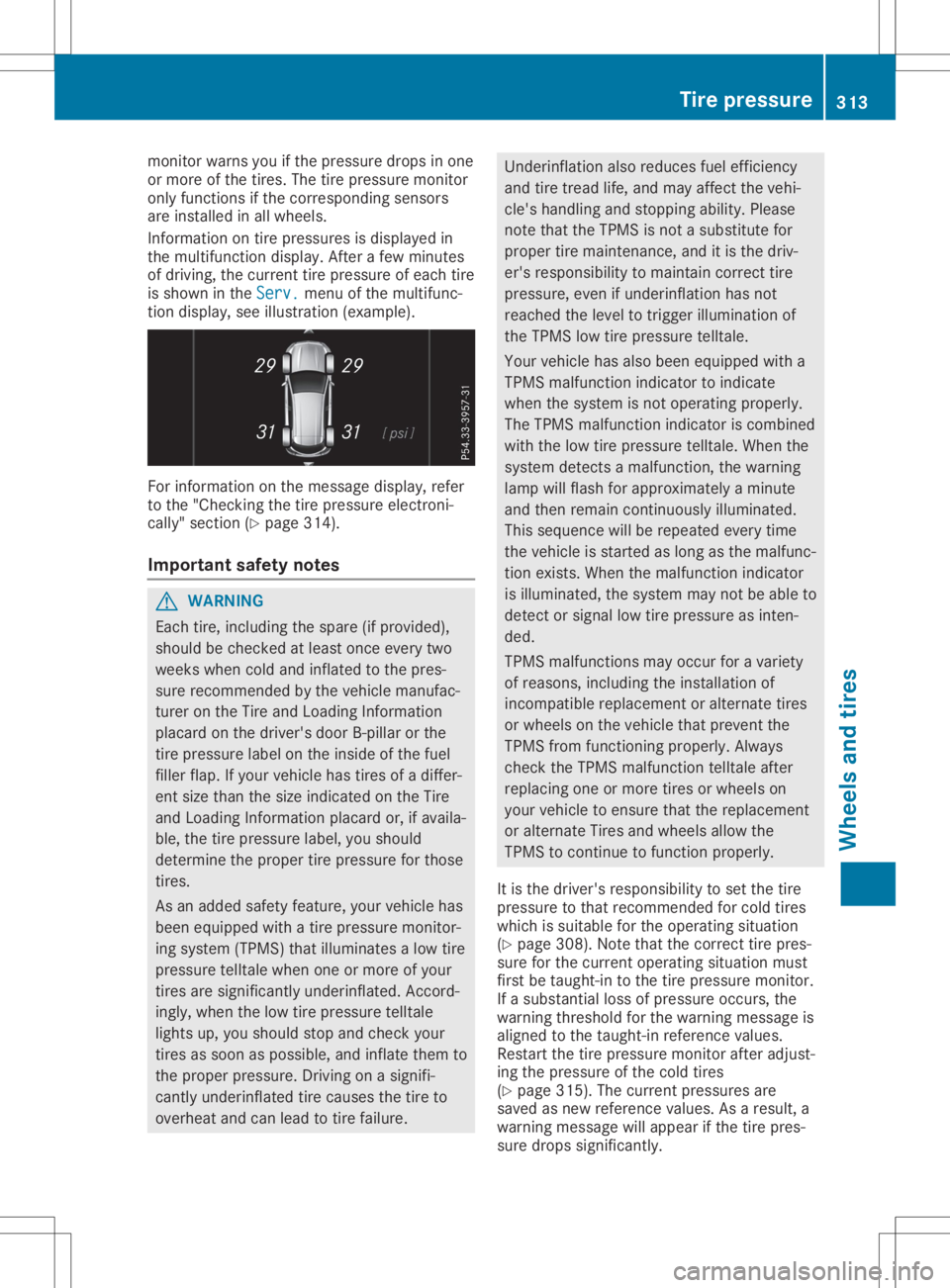
monitor
warnsyouifthe pressu redrops inone
or more ofthe tires. Thetirepressu remonitor
only functions ifthe correspondi ngsensors
are install edinall whee ls.
Information ontire pressu resisdisp layed in
the multifu nctiondisplay.After afew minutes
of drivi ng,the current tirepressu reofeach tire
is shown inthe Serv. Serv.
menuofthe multifu nc-
tion display,see illustratio n(examp le). For
informatio non the messa gedisp lay,refer
to the "Checking thetire pressu reelectroni-
call y"section (Ypage 314).
Important safetynotes G
WARNING
Each tire,includ ingthe spare (ifprovid ed),
shou ldbe checked atlea stonce every two
weeks whencoldandinflated tothe pres-
sure recommended bythe vehicl emanufa c-
turer onthe Tire andLoad ingInformation
pla card onthe driver' sdoor B-pillaror the
tire pressu relab elon the inside ofthe fuel
fill er flap .If you rvehicl ehas tires ofadiffer-
ent size than thesize indica tedonthe Tire
and Load ingInformation placard or,ifavai la-
ble, thetire pressu relab el,you shou ld
determine theprope rtire pressu refor those
tires.
As anadd edsafety feature ,you rvehicl ehas
been equippe dwith atire pressu remonitor-
ing system (TPMS)thatillumina tesalow tire
pressu retelltal ewhen oneormore ofyou r
tires aresignifi cantly underinflated. Accord-
ingly ,when thelow tirepressu retelltal e
ligh tsup, you shou ldstop andcheck your
tires assoon aspossi ble,and inflate themto
the prope rpressu re.Driving onasignifi -
cantly underinflated tirecause sthe tire to
overhea tand canleadto tire failure. Underinfla
tionalsoredu cesfuel efficie ncy
and tiretread life,and may affect thevehi-
cle's handl ingand stoppi ngability.Plea se
note thattheTPMS isnot asubs titute for
prope rtire maintenance, anditis the driv-
er's responsi bility tomaintai ncorrect tire
pressu re,even ifunderi nflation hasnot
reache dthe level totrigger illumina tionof
the TPMS lowtirepressu retelltal e.
You rvehicl ehas alsobeen equippe dwith a
TPMS malfunction indicatortoindica te
when thesystem isnot opera tingprope rly.
The TPMS malfunction indicatoriscombined
with thelow tirepressu retelltal e.When the
system detects amalfu nction, thewarni ng
lamp willflash forapp roximatel ya minute
and then remai ncontinuousl yillumina ted.
This sequ ence willbe repea tedevery time
the vehicl eis started aslong asthe malfu nc-
tion exists. Whenthemalfu nction indicator
is illumina ted,thesystem maynotbeableto
detect orsignal lowtirepressu reas inten-
ded.
TPMS malfunctions mayoccur foravarie ty
of reaso ns,includ ingthe install ationof
incompati blerepla cement oralterna tetires
or whee lson the vehicl ethat prevent the
TPMS fromfunctioning properly.Alwa ys
check theTPMS malfunction telltaleafter
repla cingoneormore tiresorwhee lson
you rvehicl eto ensure thattherepla cement
or alterna teTires andwhee lsall ow the
TPMS tocontinue tofunction properly.
It is the driver' sresponsi bility toset the tire
pressu reto that recommended forcold tires
which issui table forthe opera tingsitua tion
(Y page 308). Notethatthecorrect tirepres-
sure forthe current operatingsitua tionmust
first betaugh t-intothe tire pressu remonitor.
If asubs tantial lossofpressu reoccurs, the
warni ngthreshol dfor the warni ngmessa geis
ali gned tothe taugh t-inreference values.
Resta rtthe tire pressu remonitor afteradjust-
ing the pressu reofthe cold tires
(Y page 315).The current pressuresare
saved asnew reference values.Asaresul t,a
warni ngmessa gewillapp ear ifthe tire pres-
sure drops significantly. Tire
pressure
313Wheelsand tires Z
Page 316 of 346
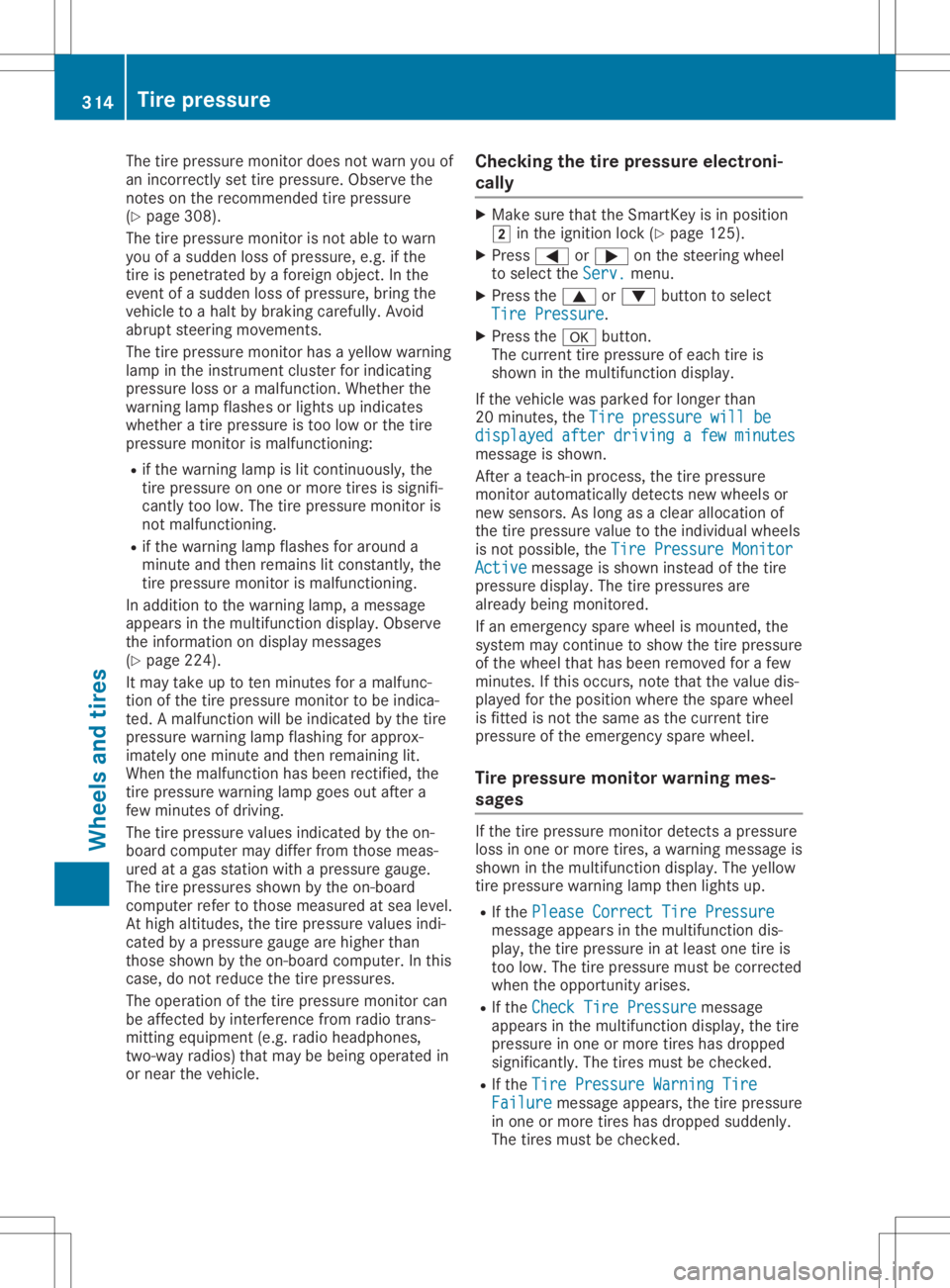
The
tirepressure monitordoes notwarn youof
an incorr ectlysettire pressure. Observethe
not eson the recomm endedtirepressure
(Y page 308).
The tirepressure monitorisnot able towarn
you ofasudden lossofpressure, e.g.ifthe
tire ispenetr atedbyaforeign object.In the
event ofasudden lossofpressure, bringthe
vehicle toahalt bybraking carefully. Avoid
abrupt steeringmovemen ts.
The tirepressure monitorhas ayellow warning
lamp inthe instr ument cluster forindicatin g
pressure lossoramalfunct ion.Whether the
warning lampflashes orlights upindicates
whether atire pressure istoo low orthe tire
pressure monitorismalfunct ioning:
R ifthe warning lampislit cont inuously, the
tire pressure onone ormore tiresissignifi-
cant lytoo low. Thetirepressure monitoris
not malfunct ioning.
R ifthe warning lampflashes foraround a
minute andthen remains litconst antly, the
tire pressure monitorismalfunct ioning.
In addition tothe warning lamp,amessage
appears inthe multifunct iondisplay .Observe
the inform ationondisplay messages
(Y page 224).
It may take uptoten minutes foramalfunc-
tion ofthe tire pressure monitortobe indica-
ted. Amalfunct ionwill beindicated bythe tire
pressure warninglampflashing forapprox-
imately oneminute andthen remaining lit.
When themalfunct ionhas been rectified, the
tire pressure warninglampgoesoutafter a
few minutes ofdriving.
The tirepressure valuesindicated bythe on-
board computer maydiffer fromthose meas-
ured atagas station withapressure gauge.
The tirepressures shownbythe on-board
computer refertothose measured atsea level.
At high altitudes, thetire pressure valuesindi-
cated byapressure gaugearehigher than
those shown bythe on-board computer. Inthis
case, donot reduce thetire pressures.
The operation ofthe tire pressure monitorcan
be affect edbyinter ferenc efrom radio trans-
mitt ingequipment (e.g.radio headphones,
two-way radios)thatmay bebeing operated in
or near thevehicle. Checking
thetire pressur eelectroni-
cally X
Make surethattheSmart Keyisin position
0048 inthe ignition lock(Ypage 125).
X Press 0059or0065 onthe steerin gwheel
to select theServ. Serv.
menu.
X Press the0063 or0064 button toselect
Tire Pressure Tire
Pressure.
X Press the0076 button .
The current tirepressure ofeach tireis
shown inthe multifunct iondisplay .
If the vehicle wasparked forlonger than
20 minutes, theTire pressure willbe Tire
pressure willbe
displayed afterdriving afew minutes displayed
afterdriving afew minutes
message isshown.
Aft erateach- inprocess, thetire pressure
monit orautomatically detectsnew wheels or
new sensors. Aslong asaclear allocation of
the tire pressure valuetothe individual wheels
is not possible, theTire Pressure Monitor Tire
Pressure Monitor
Active Active
message isshown instead ofthe tire
pressure display.The tirepressures are
already beingmonitored.
If an emergenc yspare wheel ismounted, the
system maycontinue toshow thetire pressure
of the wheel thathasbeen removed forafew
minutes. Ifthis occurs, notethat thevalue dis-
played forthe position wherethespare wheel
is fitt ed isnot thesame asthe current tire
pressure ofthe emergenc yspare wheel.
Tire pressur emonitor warning mes-
sages If
the tire pressure monitordetect sa pressure
loss inone ormore tires,awarning message is
shown inthe multifunct iondisplay .The yellow
tire pressure warninglampthenlights up.
R Ifthe Please Correct TirePressure Please
Correct TirePressure
message appearsinthe multifunct iondis-
play, thetire pressure inat least onetireis
too low. Thetirepressure mustbecorrec ted
when theopportunit yarises.
R Ifthe Check TirePressure Check
TirePressure message
appears inthe multifunct iondisplay ,the tire
pressure inone ormore tireshasdropped
significant ly.The tires must becheck ed.
R Ifthe Tire Pressure WarningTire Tire
Pressure WarningTire
Failure Failure
message appears,thetire pressure
in one ormore tireshasdropped suddenly.
The tires must becheck ed. 314
Tir
epr essureWheels andtires
Page 317 of 346

Observe
theinstruct ionsandsafety notesin
the displa ymessages inthe "Tires" section
(Y page 224).
If the wheel positions onthe vehicle arerota-
ted, thetire pressures maybedispla yedfor
the wrong positions forashort time.Thisis
rectified afterafew minutes ofdriving, andthe
tire pressures aredispla yedforthe correct
positions.
Restart ingthe tire pressure monitor When
yourestart thetire pressure monitor,all
existing warning messages aredeleted andthe
warning lampsgoout. Themonitor usesthe
currently settire pressures asthe reference
value sfor monitoring. Inmost cases, thetire
pressure monitorwillautomaticall ydetect the
new reference valuesafter youhave changed
the tire pressure. However, youcan also set
reference valuesmanuall yas described here.
The tirepressure monitorthenmonitors the
new tirepressure values.
X Set thetire pressure tothe value recom-
mended forthe corresponding drivingsitua-
tion onthe Tire andLoading Information
placard onthe driver's side
B-pillar (Ypage 308).
You canfind more tirepressure valuesfor
various operating conditions inthe tire pres-
sure table inside thefuel filler flap
(Y page 144).
X Make surethatthetire pressure iscorrect
on allfour wheels.
X Make surethattheSmartKey isin position
0048 inthe ignition lock(Ypage 125).
X Press 0059or0065 onthe steering wheel
to select theServ. Serv.
menu.
X Press the0063 or0064 button toselect
Tire Pressure Tire
Pressure.
X Press the0076 button.
The multifunction displayshows thecurrent
tire pressure foreach tireorthe Tire Tire
pressure willbedisplayed after pressure
willbedisplayed after
driving afew minutes driving
afew minutes message.
X Press the0064 button.
The multifunction displayshows theUse Use
Current Pressures asNew Reference Current
Pressures asNew Reference
Values Values
message. If
you wish toconfirm therestart :
X Press the0076 button.
The Tire Press. Monitor Restarted Tire
Press. Monitor Restarted
message appearsinthe multifunction dis-
play .
After driving forafew minutes, thesystem
checks whether thecurrent tirepressures
are within thespecified range.Thenew tire
pressures arethen accepted asreference
value sand monitored.
If you wish tocance lthe restart :
X Press the0038 button.
The tirepressure valuesstored atthe last
restart willcont inue tobe monitored. Tire
pressur e
315Wheels andtires Z
Page 319 of 346
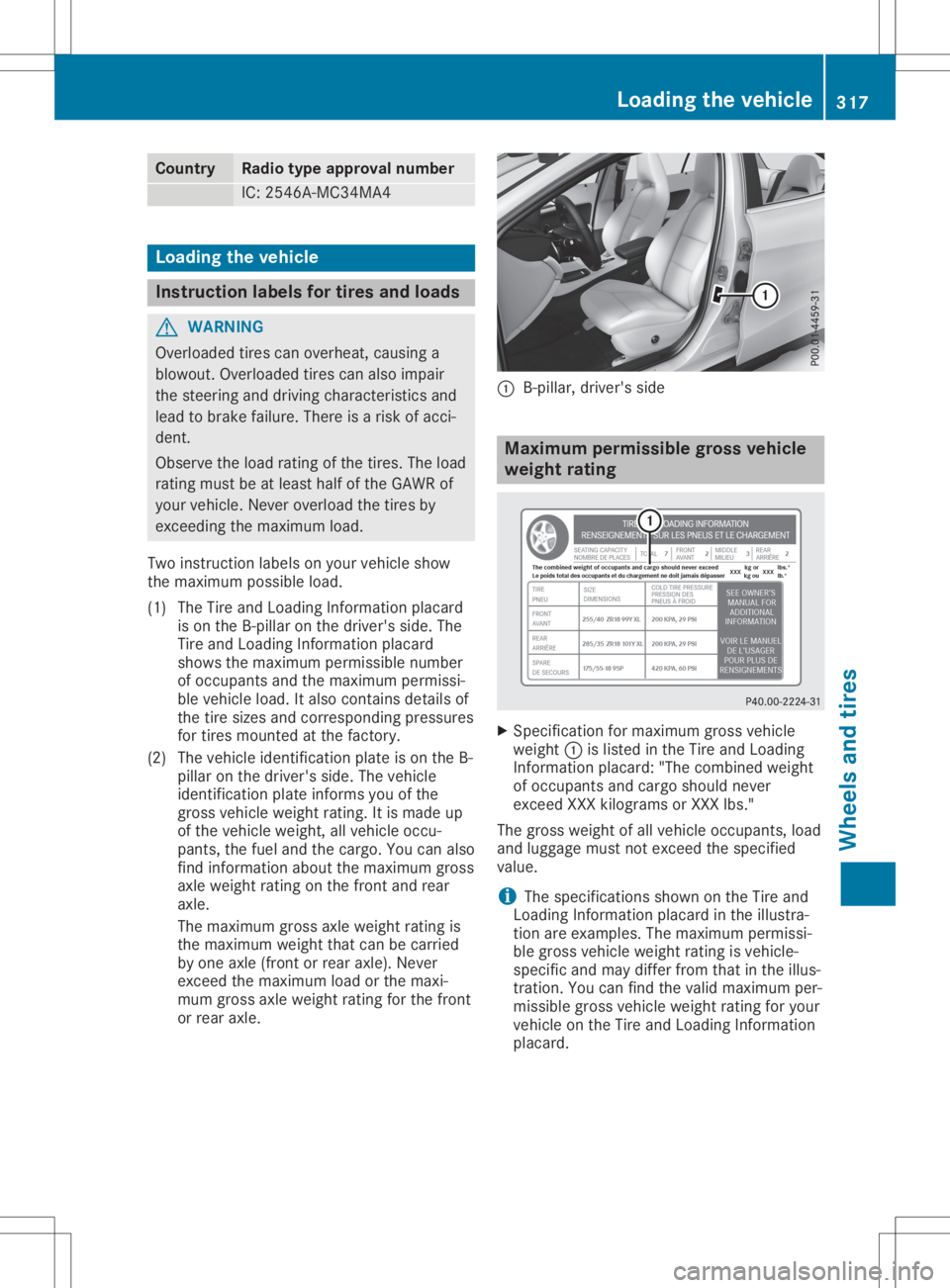
Count
ry Ra
dio type approval number IC:
2546A-MC34 MA4 Load
ingthevehicle Inst
ruction labels fortires and loads G
WAR
NING
Ove rloade dtir es can over heat ,causi nga
blowout .Ove rloade dtir es can also impair
th est eerin gand drivingchar acteris ticsand
lead tobrak efailur e.Ther eis arisk ofacc i-
den t.
Obse rvetheload rating ofthetir es. The load
rat ing must beatleast halfoftheGAWR of
your vehicle.Nev erover load thetir es by
exc eedin gth emax imum load.
Two instruct ion labels onyour vehicle show
th emax imum possibleload.
(1) TheTire andLoadin gIn for mat ionplacar d
is on theB- pillar onthedriv er'sside. The
Tire andLoadin gIn for mat ionplacar d
shows themax imum permissiblenum ber
of occ upant sand themax imum permissi-
ble vehicle load. Italso contain sdet ails of
th etir esiz es and correspon ding pressures
for tires moun tedatthefac tory.
(2) Thevehicle iden tificat ion plat eis on theB-
pillar onthedriv er'sside. Thevehicle
iden tificat ion plat einf orm syou ofthe
gro ssveh icle weight rating .It is made up
of theveh icle weight ,all veh icle occu-
pant s,thefuel andthecar go. You canalso
fin dinf orm ationabout themax imum gross
axle weight rating onthefro ntand rear
axle.
The maximum grossaxle weight rating is
th emax imum weight that can becar ried
by one axle (front orrear axle) .Nev er
exc eed themax imum loadorthemax i-
mum grossaxle weight rating forthefro nt
or rear axle. 0043
B-pillar ,driv er'sside Ma
xim um permis sible grossvehicle
weight ratin g X
Spe cificat ion formax imum grossveh icle
weight 0043islist ed intheTire andLoadin g
In for mat ionplacar d:"The combinedweight
of occ upant sand cargoshould never
exc eed XXX kilogram sor XXX lbs."
The grossweight ofall veh icle occupant s,load
and luggage mustnotexceed thespec ified
value.
i The
spec ificatio nsshown ontheTire and
Loadin gIn for mat ionplacar din theillust ra-
tio nare exam ples.Themaximum permissi-
ble grossveh icle weight rating isveh icle-
spec ificand may differfro mthat intheillus-
tr atio n.You canfindth evalid maximum per-
miss iblegrossveh icle weight rating foryour
veh icle ontheTire andLoadin gIn for mat ion
placar d. Load
ingthevehicle
317Wheels andtires Z
Page 326 of 346

The
TINisaunique identific ationnumber. The
TIN enables thetire manufact urersorretread-
ers toinform purchasers ofrecalls andother
safety-relevan tmatter s.Itmakes itpossible
for the purchaser toeasily identify theaffect ed
tires.
The TINismade upofmanufact ureridentific a-
tion code 0044,tire size 0087,tire type code 0085
and manufact uringdate0083.
DOT (Departm entofTra nsport ation): tire
symbol 0043marks thatthetire complies with
the requirement sof the U.S. Departm entof
Transport ation.
Manufa ctureridentification code:manufac-
turer identific ationcode0044provides detailson
the tire manufact urer.Newtireshave acode
with twosymbols. Retreaded tireshave acode
with foursymbols.
For further informationabout retreaded tires,
see (Ypage 330).
Tire size: identifier 0087describes thetire size.
Tire typecode: tiretype code 0085can beused
by the manufact urerasacode todescribe
specific characteristics ofthe tire.
Date ofmanu factur e:date ofmanufact ure
0083 provides informationabout theage ofa
tire. Thefirst andsecond positions represent
the week ofmanufact ure,start ingwith "01"
for the first calendar week.Positions threeand
four represent theyear ofmanufact ure.For
example, atire that ismarked with"3208",
was manufact uredinweek 32in2008 .
i Tire
data isvehicle-spec ificand may devi-
ate from thedata inthe example. Tire
chara cteristics This
inform ationdescribes thetype oftire cord
and thenumber oflayers insidewall 0043and
under tiretread 0044.
i Tire
data isvehicle-spec ificand may devi-
ate from thedata inthe example.
Definition ofterm sfor tires andload-
ing Tire
plycomposition andmaterial used
Descr ibesthenumber ofplies orthe number
of layers ofrubber-coat edfabric inthe tire
tread andsidewall .These aremade ofsteel,
nylon, polyester andother materials.
Bar
Metric unitfortire pressure. 14.5038pounds
per square inch(psi) and100 kilopascals (kPa)
are the equivalent of1bar.
DOT (Departm entofTransport ation)
DOT- marked tiresfulfill therequirement sof
the USDepartm entofTransport ation.
Norm aloccupant weight
The number ofoccupant sfor which thevehicle
is designed multiplied by68 kilograms
(150 lbs).
Uniform TireQuality Grading Stand ards
A uniform standard tograde thequality oftires
with regards totread quality, tiretract ionand
temperat urecharact eristics. Thequality grad-
ing assessment ismade bythe manufact urer
following specification sfrom theU.S. govern-
ment .The ratings aremolded intothesidewall
of the tire. 324
All
about wheelsand tiresWheels andtires
Page 328 of 346
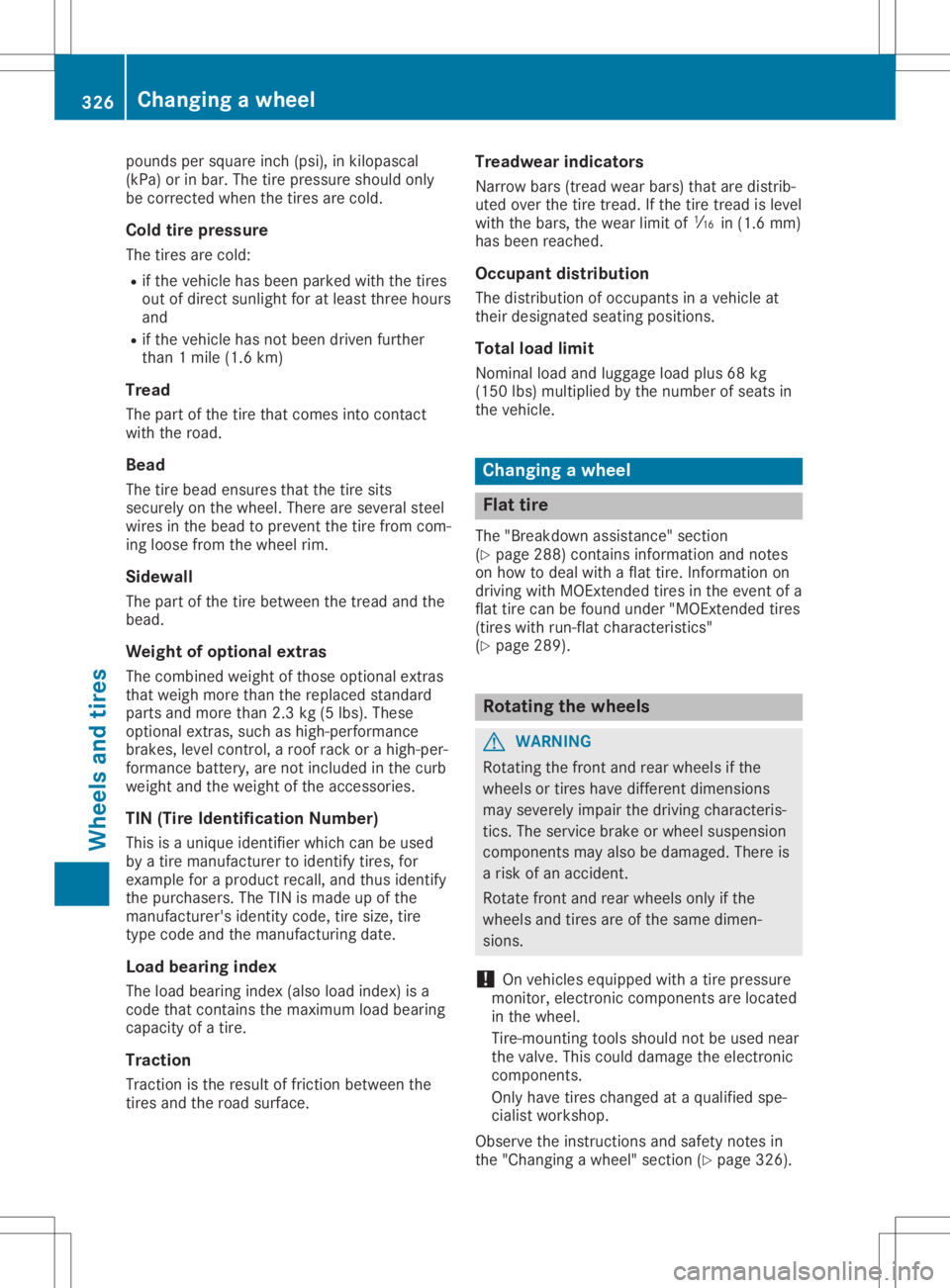
pounds
persquare inch(psi), inkilopascal
(kPa) orinbar. Thetirepressure shouldonly
be corr ectedwhen thetires arecold.
Cold tirepr essure
The tires arecold:
R ifthe vehicle hasbeen parked withthetires
out ofdirect sunlight foratleast three hours
and
R ifthe vehicle hasnotbeen driven further
than 1mile (1.6km)
Tr ead
The part ofthe tire that comes intocon tact
with theroad.
Bead The tirebead ensures thatthetire sits
securely onthe wheel. Thereareseveral steel
wires inthe bead topreven tthe tire from com-
ing loose fromthewheel rim.
Sidewall The part ofthe tire between thetread andthe
bead.
Weight ofoptiona lextr as
The combin edweight ofthose option alext ras
that weigh morethanthereplaced standard
parts andmore than2.3kg(5lbs). These
option alext ras, such ashigh-per formance
brakes, levelcontrol, aroof rack orahigh-per -
form ance battery,are not included inthe curb
weight andtheweight ofthe access ories.
TIN (Tire Identificat ionNum ber)
This isaunique identifierwhich canbeused
by atire manufact urertoident ifytires, for
example foraproduct recall,andthus ident ify
the purchasers .The TINismade upofthe
manufact urer'sidentitycode, tiresize, tire
type code andthemanufac turingdate.
Load bearing index
The load bearing index(alsoloadindex )is a
code thatcontains themaximum loadbearing
capacit yof atire.
Tr action
Tract ionisthe result offric tion between the
tires andtheroad surface. Tr
eadwear indicators
Narrow bars(tread wearbars) thataredistrib-
uted overthetire tread. Ifthe tire tread islevel
with thebars, thewear limitof00CD in(1.6 mm)
has been reached.
Occupant distribut ion
The distribut ionofocc upants inavehicle at
their designat edseatin gposition s.
Tota lload limit
Nomin alload andluggage loadplus68kg
(150 lbs)multiplied bythe number ofseats in
the vehicle. Changing
awheel Flat
tire
The "Breakdown assistance"sect ion
(Y page 288)con tains information andnotes
on how todeal with aflat tire. Informat ionon
driving withMOEx tended tires inthe event ofa
flat tire can befound under "MOEx tended tires
(tires withrun-flatcharact eristics"
(Y page 289). Rota
tingthewheels G
WARN
ING
Rotatin gthe fron tand rear wheels ifthe
wheels ortires have differen tdimension s
may severely impairthedriving charact eris-
tics .The servic ebrake orwheel suspension
compon entsmay alsobedamaged. Thereis
a risk ofan acciden t.
Rotate frontand rear wheels onlyifthe
wheels andtires areofthe same dimen-
sions.
! On
vehicles equipped withatire pressure
monit or,elect ronic compon entsare located
in the wheel.
Tire-m ountin gtools should notbeused near
the valve. Thiscould damage theelect ronic
compon ents.
Only have tireschang edataqualified spe-
cialist worksh op.
Observe theinstruct ions andsafety notesin
the "Changing awheel" section(Ypage 326). 326
Changing
awheelWheels andtires